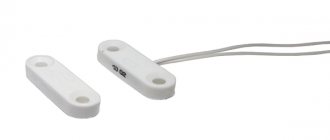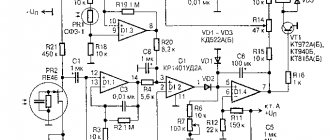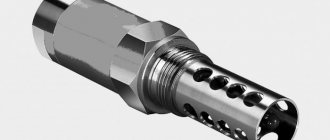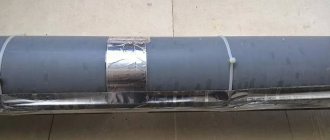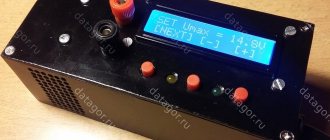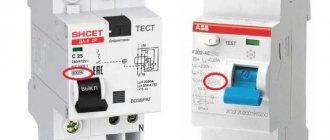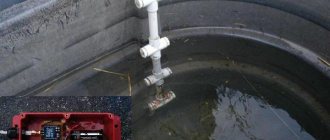Precision measuring instruments are an important component of the activities of all modern sectors of the economy. They serve for timely recording of the consumption of various liquids; they are needed when working with gas mixtures and steam.
In addition to classical flow meters with different operating principles, electronic devices that measure pressure are also often used. Such devices are a mandatory element of most measuring systems and heat meters. They are often part of systems used to implement automatic control.
So-called pressure sensors are in demand at energy sector enterprises, food production, oil refining and other industries where it is necessary to know the digital pressure value to ensure uninterrupted and safe operation of equipment.
Industrial pressure sensors. Device and types
Two types of membranes can be used as sensors: strain gauge and piezometric.
The membrane installed in the sensor can either change its electrical resistance or produce an electric current under pressure.
Since long-term pressure is applied to the membrane, the piezoresistor constantly produces a weak current, which is transmitted to the electronics unit located behind it, which processes the signal from the membrane and transmits it further to the converter. The converter, in turn, converts the received data into a unified digital signal.
To protect the sensor membrane from damage, an additional high-strength membrane is installed, and the space between them is filled with an incompressible liquid, usually oil.
The oil can be technical (usually this is the case), but in addition it can also be used for food. As a rule, this is a requirement of food production so that in the event of damage to the protective membrane or body of the product, technical oil cannot enter the working environment.
In general, all industrial pressure sensors can be divided into two types.
Relative pressure transducers usually have a connection with the atmosphere in the area of the sensor membrane. Thus, measurements are always made corrected for the atmosphere, that is, the pressure is measured relative to it.
Absolute pressure sensor TD-10.101b
Absolute pressure transducers are sealed and are not connected to the atmosphere in any way, so they measure direct pressure on the membrane.
The list of applications is very extensive for both types of converters, it all depends on the specific requests of an individual production.
Nevertheless, we note several options. Relative pressure transducers are indispensable in the field of calculating the hydrostatic pressure exerted by a column of liquid in a certain container.
If the liquid column in the container is connected to the atmosphere, then the absolute pressure transducer will measure the pressure of both the liquid column and the atmosphere, that is, it will make inadequate measurements. In such cases, only relative converters are used.
Reference. Sometimes submersible type relative pressure sensors can be called a level sensor. This is not true, such converters are called hydrostatic pressure sensors.
The differential pressure transducer can be installed in sealed containers, where two pipelines filled with an incompressible liquid, usually oil, are connected to it.
differential pressure sensor TD-12.104b
The pipelines are cut off from the space of the container by membranes, one of which is pressed by air, the other by liquid.
Why can't the sensor be allowed to come into direct contact with the liquid? Separators are necessary to compensate for sudden surges in membrane voltage when filling or withdrawing liquid from a container. The oil has sufficient inertia and makes it possible to obtain a smoother measurement characteristic. We should not forget about the banal protection of complex equipment from the external environment.
Of course, this can also create difficulties. For example, to install a membrane separator, you will have to send the device itself to the production of such membranes.
Resistive elements
These are devices in which the sensitive element changes its resistance under the influence of load. A strain gauge is installed on the sensitive membrane. The membrane bends under pressure, and the strain gauges also begin to move. At the same time, their resistance changes. As a result, the current strength in the converter circuit changes.
When strain gauge elements are stretched, the length increases and the cross-sectional area decreases. The result is an increase in resistance. The reverse process is observed when elements are compressed. Of course, the resistance changes by thousandths of an ohm, so to catch this, you need to install special semiconductor amplifiers.
Areas of use
There are a large number of different applications using special types of membranes. For example, the membrane of a general industrial sensor can be recessed into the housing; externally, such a sensor can have a thread and a channel leading to it. Sometimes a damper can be installed in it for additional shock absorption (typical for measuring compressed air pressure).
General industrial pressure sensor TD-10.107b
Such designs are not suitable for the food and pharmaceutical industries, because they clog easily and quickly, disrupting the operation of the device. In such cases, industrial pressure sensors with a flat membrane are used, usually made of a denser material than usual (although the design remains extremely sensitive, so you should not touch the membrane with your hands).
Stainless steel is usually used as a material for membranes, as well as for the body. Other materials can be used, for example, ceramics - a cheaper material, but not providing exceptional precision.
Pressure sensor with flat membrane TD-13.102b
The most common accuracy of pressure sensors is 0.5% and 0.25%. High-precision products include devices with an accuracy of 0.1% and 0.05%, sometimes 0.03% can be found. As a rule, any accuracy in the technical characteristics of a device is given at a temperature of + 25 C. That is, any converter has a certain temperature dependence.
Products are temperature compensated over a temperature range from +5 to +80 C. Thanks to this setting, the temperature shift in measurements will not have such a strong effect. Some applications offer compensation up to 125 C to improve measurement performance at high temperatures.
High temperature pressure sensor TD-10.130b
Industrial pressure sensors have another very important indicator - long-term stability of the sensor. This indicator is measured in % of the URL (upper limit of measurement) and characterizes the deviation of the measurement accuracy from the zero point during the operation of the product. This is a natural process, it cannot be avoided, and the problems it creates can be solved through periodic calibration of the product.
Industrial pressure sensors can also be divided by measurement range, that is, URL.
The upper limit of measurement is the maximum pressure for the transducer membrane, calculated in bar.
Of course, there is also a lower measurement limit that characterizes the minimum pressure for a response. As a rule, it ranges from -1 (vacuum) to 1 bar, but for some rare applications products with a different NPI, for example, 10 bar, can be produced. This may be necessary if the enterprise needs to measure a very narrow range of pressures.
NPI -1 bar is typical for vacuum sensors used to measure vacuum.
High pressure sensor TD-10133
The ranges are divided according to standard solutions and represent pre-established templates. For example, after 10 kPa there may be 30 kPa, and finding 20, even if they are needed, will not be an easy task.
The standard range of URLs for most manufacturers are 6, 10, 16, 25 and 100 bar.
Reference. Not all businesses use bars or atmospheres. Some industries use kPa (kilopascals). This can be an important detail, since a particular PLC may use certain units of measurement and if they do not match, adjustments may be needed.
Classification
Pressure sensors are classified according to several criteria. The first of these is the measured characteristic:
- Absolute pressure is an indicator in the measured medium relative to absolute zero (vacuum).
- Excess pressure is the level of increase in pressure in a medium relative to barometric pressure (in the earth’s atmosphere).
- Rarefaction is the degree of decrease in pressure relative to barometric pressure.
- Pressure/vacuum: both increases and decreases relative to atmospheric pressure can be measured.
- Pressure differences (differential): measure how different the readings are in two different environments or at 2 remote points in a process.
- Hydrostatic: measure the difference between total and dynamic pressure, used for pipelines.
Another classification is based on the method of measuring pressure:
- The height of the liquid in the column. Pressure gauges with a calibrated scale, filled with water or mercury, operate on this principle. Aquatic ones are considered more sensitive and accurate.
- Elastic deformation. The method is based on this correspondence: the degree of deformation of an elastic material is directly proportional to the applied force (pressure).
- Electrical methods. Strain gauges work on this principle: a change in size affects the electrical resistance of the conductor.
Depending on all these characteristics, the following types of sensors are distinguished:
- Elastic sensors are often used to measure fluid pressure. They are a device with liquid in a compartment with one elastic wall. this elastic “membrane” deflects as the readings change, and a value is calculated based on these deviations. Such devices are sensitive and fragile, and become confused when exposed to vibrations.
- Bourdon tubes: pressure is applied inside the tube, which causes its elastic deformation (an ellipse or oval in cross-section tends to take the shape of a circle, and the free end of the tube moves). Most often, pressure gauges with a pointer dial operate on this principle. These are portable models that require little maintenance, but operate with low accuracy and are only suitable for static measurements.
- Bellows: cylindrical devices with folds that deform when compressed and expanded. Such devices are connected to switches and can only be used at pressures below 200 Pa.
- Membranes and diaphragms are rubber, metal, plastic or leather discs. They are sensitive to sudden changes in pressure, and are also suitable for measuring low values, less than 2-7 Pa. Can also be used in aggressive environments.
- Electrical sensors are installed on a par with elastic ones, increasing measurement accuracy and ensuring the transmission of an electrical signal to the control point.
- Capacitive, consisting of parallel capacitor plates connected to a metal diaphragm. The design also contains electrodes powered by a high-frequency generator. Suitable for measurements in the range of 2.5-70 MPa.
- Inductive, with a ferromagnetic core, windings and an elastic element. The core moves as the pressure changes, and the voltage between the windings also changes. Depending on the degree of stress calibration and the type of elastic element, the range of measured values can vary from 250 Pa to 70 MPa.
- With magnetoresistance. They are a structure with a ferromagnetic core, plate and flexible elements. When they move, the magnetic flux of the circuit changes. The measurement sensitivity in this case is 0.35 MPa.
- Piezoelectric with a crystal sensor that generates an electrical charge at the moment it senses pressure. There is a direct relationship between changes in these quantities, so the device is sensitive, with fast response (low response time). The sensitivity in this case is also at a level within 0.1 MPa, and the upper measurement limit is 100 MPa.
- Potentiometric ones are equipped with a lever attached to an elastic sensor. When the elastic element is deformed, the lever moves across the potentiometer, thereby providing a resistance measurement. Such sensors operate with low sensitivity and are not suitable for continuous use in critical processes.
- Strain gauge: Pressure changes are determined by calculating the resistance variations of a Wheatstone bridge circuit. The sensitivity of the sensors remains high only if the process temperature is stable. Measurement range - up to 1400 MPa with sensitivity 1.4-3.5 MPa.
- Vibrating (with vibrating element). In this case, changes in the resonant frequency of vibrating elements are measured, and the sensor itself is located in an insulated cylinder under vacuum. Such devices are suitable for measuring stable values without sudden jumps and are practically not affected by temperatures. The permissible measurement range is up to 0.3 MPa.
- Differential pressure: The pressure difference is measured and this value is converted into a transmitted signal. Used in conjunction with a capacitive element or a diaphragm, it is considered minimally invasive. The sensitivity of measurements and their range depend on which electrical and elastic elements are used in the design. Most often, such devices are used to measure differences in quantities.
- Vacuum or vacuum gauges operate at subatmospheric pressure, in a vacuum, or at extremely low pressures.
- Thermal, they work on the principle of vacuum gauges, when gas thermal conductivity changes due to pressure. The principle used in this type of sensor is to change the gas thermal conductivity under the influence of pressure. Such sensing elements only operate at low pressures.
- Ionization devices can be with a hot or cold cathode (they differ in the principle of electron emission). Such devices are considered very sensitive and are suitable for measuring fractional parts.
Devices with varying degrees of sensitivity are also available. Some work with minimal error, but require more time to take measurements. It is advisable to use them where the pressure in the system is stable. If this value changes greatly in a short period of time, then they decide to “sacrifice” accuracy in favor of the speed of measurements.
Connecting pressure sensors
Here we cannot say that there are well-established standard connections; they may differ in different industries.
Mostly threaded connection is used.
Gas thread connections (G) typically have diameters of 1.4 or 1.5 inches.
Metric threads are characterized by M20×1.5 and M12×1.5.
Refrigeration systems have unusual thread standards. What to do if the diameter is not suitable? For pressure transducers, a fairly large number of adapters are produced from various materials. Stainless steel is commonly used, but brass and other materials may be found.
Joining a process
Attaching a pressure sensor to a process is the method of mounting a device for making measurements - to a pipeline, impulse line, etc. Sensors are classified according to the type of mechanical connection:
- With threaded connections.
- With flange connections.
- Hygienic connections.
- Submersible.
General industrial versions of pressure sensors are most often mounted using threaded connections G1/2″ DIN 16288 and M20x1.5.
Output signals
In most cases, industrial pressure sensors use an output signal of 4...20 mA or 0 - 10 V, which are the most common.
In some cases, devices with ratiometric output can be produced.
Such a signal differs in the dependence of its value on the supply voltage. As a rule, this is a signal in the range of 0.5 ... 4.5 V. In fact, “0.5 ... 4.5 V” are such only at a stable voltage of 5 V. If the value of the supply voltage changes, then the output signal will change proportionally.
Electrical connection uses DIN 650 and DIN 43 standards, miniDIN is also available.
It is interesting to connect pressure meters to a PLC (programmable logic controller), which occurs through a closed current loop. The fact is that industrial pressure sensors have only one positive analog output, which is connected to the positive analog input of the PLC, after which the positive power output of the sensor is connected to power.
Current loop
Thus, industrial pressure sensors are powered from their own output signal. This circuit is very economical and convenient, but has a power limit of 20 mA.
Sometimes galvanic isolation is installed in such a circuit, which are modules that separate the power supply for the PLC and the sensor, which helps protect the equipment from power surges.
Measuring range
The measurement range of a pressure sensor is the maximum and minimum values that the device will measure and convert into an output signal. Therefore, it is necessary to select a sensor whose measurement range corresponds to the pressure range of the intended measurements. In this case, both normal operating conditions and random pressure fluctuations must be taken into account.
There are high and ultra-high pressure sensors, low and ultra-low pressure sensors, and medium pressure converters.
| DMP 334 high and ultra high pressure sensors | DPS+ ultra-low pressure sensors |
Industrial pressure transmitters for large plants
At large industrial enterprises you can find other options for pressure converters. They are more massive, have a much greater variety of connections and sometimes support wireless communications and digital solutions.
Pressure sensor VegaBar 38
A good example of such products is the VEGA company, which develops a large number of solutions for the largest enterprises. There is an article on our website with a detailed description of the products of this company. You can also order the supply of VEGA equipment to Russia.
Criterias of choice
When selecting a suitable device, be sure to take into account:
- installation location, type of technological process and equipment;
- measurement range;
- type and temperature of the transported medium;
- type of unified output signal;
- required accuracy of measurements (the more critical the technological process, the higher the accuracy required).
offers the most popular sensors, masters, recorders, sensors and pressure transducers with high accuracy. You can also purchase digital pressure gauges here.
All these are products of the Swiss company KELLER. Such equipment has high accuracy, stability, reliability of electrical connectors and process connections. To select a suitable measuring device in accordance with the requirements of the technological process and equipment, just leave an online application or request a call back.
